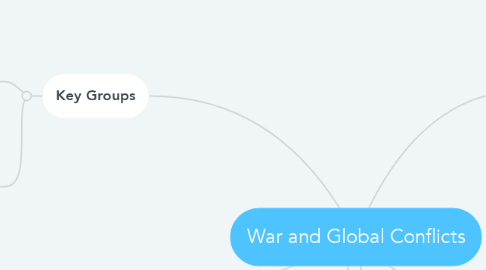War and Global Conflicts
by Hana Zahic

1. Key Groups
1.1. The United Nations has failed several peacekeeping missions around war- torn areas (United Nations Srebrenica 2010). which leads citizens to ask the question: "Who allows this to occur?"
1.2. The American government is one of the most powerful in the entire world, usually making decisions regarding war. President Donald Trump has continued to spread islamophobic terrorist propaganda. This leads citizens to believe them, and become controlled.
2. Citizen's Duty
2.1. The citizens have a duty of protecting one another and standing up to global conflict, as can be done in protests against corruption such as the current ones seen for George Floyd and police brutality.
2.2. The regular person has spent decades believing that a change cannot be made because they do not have a voice, and now the citizens must be heard although they continue to have fear of the government.
3. Solutions
3.1. 1. Standing up to the key groups involved and recognizing their faults, such as the UN failure to defend Srebrenica, to make sure that key players' corrupted influence does not happen again.
3.2. 2. Recognizing that the media is controlled by major corporations and that globalization means harmful effects to the East
3.3. 3. Using media and petitions to spread awareness and donating to personal people who have been affected by war and the overall corruption of the system.
4. What is the Conflict?
4.1. Several wars around the world have been perpetrated by the American government, with a rising agenda against Muslims.
4.2. Islamophobia rates have been on the rise in The United States since the 9/11 attacks, which means that citizens do not question why the US military has been attacking thousands of Afghan and Iraqi citizens for over a decade.
4.3. Three of the wars that give examples to the problem of mass propaganda surrounding war include the Afghanistan war of 2001, the Iraq War of 2003, and the Yugoslav wars of 1992-1995.
5. Conflict Theory
5.1. As the conflict theory states that problems are sparked through uneven distribution of resources or inequality in a nation, this was seen in the Yugoslav wars. The Serbian perpetrators were fully equipped, and this gave them an advantage against the Bosnian Muslims. (NATO).
5.2. Wars are brought onto Eastern land, although countries such as Afghanistan are already at a disadvantage of resources and wealth.
6. Tension Theory
6.1. The tension theory of social change describes how a change in beliefs or a fear of a certain group can cause further conflict. This is one that is usually referred to the post-wars of 9/11, and the Islamophobia content after it. Afghanistan and Iraq are two of the countries that America invaded after looking to defeat terrorism. (Crawford et al.)


